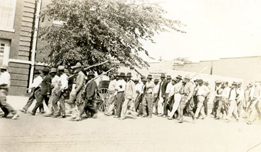 By Sojourner’s Truth Staff
By Sojourner’s Truth Staff
One hundred years ago, in Tulsa, Oklahoma, on Memorial Day weekend, 19-year-old Dick Rowland, a Black shoe shiner, was arrested and accused of assaulting Sarah Page, 1 17-year-old White elevator operator.
Rumors began to spread that he would be lynched as a group of White men gathered at the jail where he was held. About 75 Black men, some armed, also gathered at the jailhouse to make sure that a lynching did not occur. Given assurances by the sheriff that there would be no lynching, the group of Black men were convinced to leave, but returned when they heard the White group had not similarly been dispersed. They were accosted by a group of White men and “all hell broke loose,” according to the sheriff.
Twelve people were killed – 10 White men and two Black men – and news of the incident spread around the city. Mob violence resulted and the target was Greenwood.
The History of Greenwood
Large numbers of African Americans had arrived in Oklahoma during the 19th century, first due to the removal of Native Americans and their forced march west; then during the land rushes in the last decade of the century.
At the start of the 20th century, O.W. Gurley, a wealthy landowner from Arkansas, arrived in Oklahoma as part of the land rush crowd. He moved to Tulsa in 1906 and purchased 40 acres of land on which he would build a rooming house, three two-story buildings and five residences. He also purchased an 80-acre farm in a nearby county.
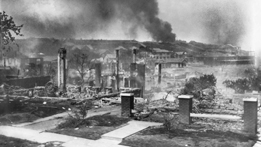 Greenwood, as the area became known, also earned the moniker of the “Black Wall Street,” as it became one of the most commercially successful African-American communities in the country. The area attracted many new residents and visitors, such as Booker T. Washington. New Black arrivals were also enticed by the opportunity to strike it rich in the booming Oklahoma oil fields.
Greenwood, as the area became known, also earned the moniker of the “Black Wall Street,” as it became one of the most commercially successful African-American communities in the country. The area attracted many new residents and visitors, such as Booker T. Washington. New Black arrivals were also enticed by the opportunity to strike it rich in the booming Oklahoma oil fields.
Greenwood Avenue was one of the few streets that did not cross through both black and white neighborhoods, and in 2006, shortly after Washington’s visit, the Greenwood neighborhood was formally established. By 1921, it was home to about 10,00 Black residents – Pine Street to the north, Archer Street and the Frisco tracks to the south, Cincinnati Street on the west and Lansing Street on the east.
Hannibal Johnson, author of Black Wall Street: From Riot to Renaissance in Tulsa’s Historic Greenwood District, writes that the area survived economically by keeping money within the community.
“Thew district really took off as an economic and entrepreneurial kind of Mecca for Black folks because this was an era of segregation. Black folks were shut out from the dominant white-led economy in what I call an economic detour. In other words, when they approached the gate of economic opportunity at the white dominated downtown Tulsa economy, they were turned away. So they created their own insular economy in the Greenwood district and blossomed because dollars were able to circulate and recirculate within the confines of the community because there was not much of an option, given the segregation that existed here and elsewhere.”
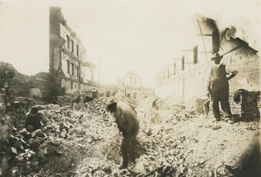 “Greenwood was an incredibly vibrant and energetic place,” says Scott Ellsworth, historian and author of The Ground Breaking, a historical investigation into the Tulsa massacre. “There were 35 restaurants. There was an equal number of grocery stores and meat markets. There were a dozen churches … two African-American schools, a black public library branch and an African-American hospital.”
“Greenwood was an incredibly vibrant and energetic place,” says Scott Ellsworth, historian and author of The Ground Breaking, a historical investigation into the Tulsa massacre. “There were 35 restaurants. There was an equal number of grocery stores and meat markets. There were a dozen churches … two African-American schools, a black public library branch and an African-American hospital.”
Such prosperity did not go unnoticed in the white community especially as the Ku Klux Klan was gaining power and influence. Voting restrictions in the form of poll taxes and literacy test for Black voters were the norm and were regularly upheld by the state courts.
“You have a really successful Black business community across Frisco tracks, literally across the track from downtown Tulsa,” says Johnson. “You have white people, some of whom are not doing well economically, who can look across those tracks and see Black people in homes, driving cars, furnishing their homes with pianos, women wearing furs, all the trappings of economic success. And so there’s that dissonance between what these people think ought to be, based on white supremacy, and what actually is. And one of the ways to harmonize that dissonance is to bring the Black folks down a peg through violence.”
The Memorial Day Weekend Massacre
The White mob turned its destructive violence on Greenwood and wreaked havoc on the community over the Memorial Day weekend.
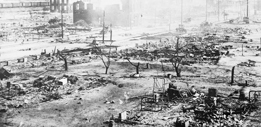 On May 31, 1921 and into the following day, the White mob destroyed Greenwood. The attack was carried out not only by the mob on the ground but also by private aircraft dropping bombs on the district.
On May 31, 1921 and into the following day, the White mob destroyed Greenwood. The attack was carried out not only by the mob on the ground but also by private aircraft dropping bombs on the district.
An estimated 300 people were killed, about 1,200 homes were burned to the ground along with at least 60 businesses, all the churches, a school, the hospital and the public library, according to a report by the Human Rights Watch. At least $1.5 million in damages – about $32 million in today’s dollars – were claimed, but that is said by experts as an underestimation.
More than 800 people were hospitalized and as many as 6,000 Black residents were interned by the National Guard. About 10,000 residents were left homeless.
The years following the Tulsa massacre were filled with … silence. Many survivors left Tulsa and those who stayed in the city, both Black and White residents, stayed silent for decades. The massacre went unacknowledged in local and national histories and news reports.
In 1996, 75 years later, a bipartisan group in the state legislature formed the Oklahoma Commission to Study the Tulsa Race Riot of 1921 and ultimately recommended a program of reparations for survivors and their descendants. A park memorializing the victims was dedicated in 2010 and in 2020 became part of the Oklahoma school curriculum.
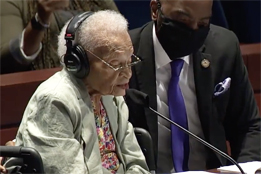
Recently, several survivors testified before the United States Congress about the events of 100 years ago, among them Viola Fletcher.
On May 31, 1921, Viola Fletcher was seven years old. The 107-year-old survivor said this to Congress two weeks ago:
“I will never forget the violence of the white mob when we left our home. I still see Black men being shot., Black bodies lying in the street. I still smell smoke and see fire. I still see Black businesses being burned. I still hear airplanes flying overhead. I hear screams. I have lived through the massacre every day. Our country may forget this history, but I cannot. I am 107 years old and I have never seen justice. I pray that one day I will. I have been blessed with a long life and have seen the best and the worst of this country. I think about the terror inflicted upon black people in this country every day.”
